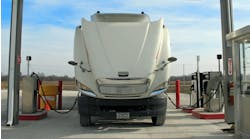As fleets explore their options for decarbonization, the Shell Starship program has demonstrated how fleets can increase their fuel efficiency and lower emissions with greater aerodynamics and powertrain efficiency without transitioning to hydrogen fuel cell or electric vehicles. The Shell Starship 3.0 took this concept further using a Cummins X15N natural gas engine, specialized tires from Bridgestone, and renewable natural gas from Trillium Energy Solutions. While each of these elements can help fleets with their sustainability goals on their own, taken together they helped provide Starship 3.0’s results.
Read more: First look at Shell Starship 3.0
The third generation of Shell’s Starship truck completed its journey October 2023, travelling 840 miles throughout California and displaying a freight ton efficiency (FTE) 2.542 times better than the U.S. average for Class 8 diesel trucks, and 3.23 times better based on ton-miles per kg of CO2e emitted. Even when operating at a gross vehicle weight of 80,000 lbs., the Shell Starship 3.0 performed .06 times better than the previous generation in 2021, largely through lowering aereo dynamic drag, emphasizing lightweighting, and using low rolling resistance tires.
Fuel-efficient components
Of the specific additions to Shell Starship 3.0 that contributed to its results, the Shell team used Ecopia and Greatec tires to improve rolling resistance.
“Bridgestone partnered with Shell to equip the Shell Starship 3.0 with Bridgestone R213 Ecopia steer tires and Greatec R197 drive and trailer tires,” said Tanya Miracle, director, TBR and retread OE account management, Bridgestone Americas. “The Ecopia line is designed to provide eco-friendly performance through higher fuel efficiency and safety, while the Greatec R197 offers improved rolling resistance and optimum fuel efficiency.”
These improvements allowed the Shell team to reduce their vehicle weight for better fuel use. Meanwhile, the Starship powertrain had to be adapted for natural gas, which meant updating several internal elements, from the aftertreatment system to the transmission.
“Cummins brought in the full powertrain starting from the X15N engine, after-treatment system, CCFT (Cummins Clean Fuel Technologies) fuel delivery system, Eaton Cummins transmission, and the Meritor axle,” said Puneet Jhawar, GM, Global Spark Ignited and Fuel Delivery Systems.
Additionally, Jhawar explained how Cummins worked with Shell and their collaborators on the Starship 3.0’s CAD models, ensuring that the truck could accommodate the X15N powertrain, transmission calibration, and engine adaptations.
Finally, Trilium Energy Solutions supplied the Starship with the renewable natural gas.
What fleets can learn
While there is still work to be done regarding commercial vehicle sustainability, the Shell Starship 3.0 collaborators found the results to be encouraging, particularly in the development of future technology.
“The results of the Starship 3.0 will help our team of engineers make our products even better, as well as help position our tire technology to better align with other new sustainable technologies,” Miracle stated.
On a broader scale, the project also displayed the viability of sustainable technology today, a critical factor as emissions regulations across the country, such as California’s Clean Truck Check Program, go into effect.
“The program was able to demonstrate that a heavy-duty fleet can decarbonize quickly and have a big impact on the ESG and sustainability goals while not compromising on range, payload and fueling infrastructure,” Jhawar asserted.




